Purpose of flooring is to get a good hard, level and beautiful surface for living. The floors directly resting on the ground are known as ground floors while the floors of each storey are known as upper floors.
Ground Floor
Apart from giving good finished surface, these floors should have good damp resistance. The ground surface is rammed well and a layer of red earth or sand is placed which is compacted. A layer of broken bricks, stones etc. is provided up to 150 mm below floor finish level and rammed. While ramming the surface is kept moist to get good compaction. Then 1 : 4 : 8 concrete of 100 to 150 mm thickness is provided as base course. Over this bed floor finish is laid.
The types of flooring used are:
1. Mud and moorum 2. Brick
3. Flag stone 4. Cement concrete
5. Terrazo 6. Mosaic
7. Marble 8. Tiles
9. Timber 10. Rubber
11. P.V.C.
1. Mud and Moorum Flooring: These floorings are used in low cost housing, specially in villages. Over the hard layer of earth filling mud or moorum layer is provided. The floor needs a thin wash of cow dung at least once a weak.
2. Brick Flooring: This is also a cheap floor construction. It is commonly used in godowns and factories. Bricks are laid flat or on edges. Bricks of good quality should be used for the construction. Brick layer is provided on sand bed or on lean concrete (1 : 8 : 16) bed. In both cases joints are rendered flush and finished with cement mortar.
3. Flag Stone Flooring: Laminated sand stones or slates of 20 mm to 40 mm thick in the form of slabs of 300 mm × 300 mm or 450 mm × 450 mm or in the form of rectangles of size 450 mm × 600 mm are used as floor finishes. The stone slabs are laid on 20 to 25 mm thick mortar spread over concrete bed. The joints are to be finished with rich mortar.
4. Cement Concrete Floors: It is modestly cheap and durable floor and hence commonly used in residential, commercial and industrial buildings. It consists of two courses-base course and wearing coat. Base course is laid over well compacted soil. Its thickness is usually 75 mm to 100 mm. It consists of lean cement concrete mix (1 : 4 : 8) or lime concrete containing 40% of 1 : 2 lime mortar and 60% of coarse aggregate of 40 mm size. After base coarse is hardened wearing coat of 40 mm is laid. It consists of panels of 1 m × 1 m, 2 m × 2 m or 1 m × 2 m. Alternate panels are laid with 1 : 2 : 4 concrete using wooden, glass or asbestos strip separators of 1.5 mm to 2.0 mm thickness. To get good bond between base coarse and wearing coat cement slurry wash is given before laying wearing coat panels. After 34 days of laying of one set of panel, another alternate panels are laid. Top of these panels are finished by tamping the surface with wooden floats and tapping with trowels, till cement slurry appears
on top. It needs curing for 7 to 14 days. To get good appearance many times red-oxide
finishing coat is provided.
5. Terrazo Flooring: Terrazo finishing coat is applied over concrete flooring to get pleasing appearance. Terrazo finish consists of 75 to 80% of surface marble chips embedded in cement mortar.
Marble chips are mixed in cement in the proportion 1 : 1.25 to 1 : 2 and about 6 mm terrazo topping is laid. The top is tamped and rolled. Additional marble chips are spread during tamping to get proper distribution of marble chips on the surface. After drying it for 12 to 20 hours, it is cured for 23 days.
Then grinding is made in the following three steps:
Ist grinding Using coarse grade (No. 60) carborundum stones.
IInd grinding Using medium grade (No. 120) carborundum stones.
IIIrd grinding Using fine grade (No. 320) carborundum stones.
Plenty of water is used during grinding. After each grinding cement grout of cream-like
consistency is applied and cured for 67 days. After final grinding and curing the floor is washed with plenty of water and then with dilute oxalic acid solution. Then floor is finished with polishing using machines and wax polish.
6. Mosaic Flooring: It consists of a finishing coat of small pieces of broken tiles of China glazed or of marble arranged in different patterns set in lime-surkhi or cement mortar. The base coarse is concrete flooring and on it 30 to 40 mm mortar layer is provided. On this mortar layer broken pieces of China glazed or marble are set to get different attractive patterns. After 20 to 24 hours of drying the top is rubbed with carborundum stone to get smooth and polished surface.
7. Marble Flooring: Marble slabs are cut to get marble tiles of 20 to 25 mm thickness. They are laid on floors similar to other tiles. With power driven machine surface is polished to get even and shining surface. This type of flooring is widely used in hospitals and temples.
8. Tiled Flooring: This is an alternative to terrazo flooring, used commonly used in residential, office and commercial buildings. Tiles of clay, cement or terrazo of standard sizes are manufactured in factories under controlled conditions. On the concrete base, 25 mm to 30 mm thick mortar is laid and these tiles are placed and pressed with trowel or wooden mallet. Before placing tiles care is taken to see that, neat cement slurry is applied to bottom side and sides of tiles to get good bond. Next day joints are cleaned of loose mortar and raked up to 5 mm depth. Then that is filled with coloured cement slurry to get uniform colour on the top surface. After curing for 7 days grinding and polishing is made as in the case of terrazo flooring.
9. Timber Flooring: Timber flooring are used in dancing halls and in auditoriums. Timber plates may be directly placed on concrete bed or may be provided over timber frame work. In latter case it is necessary to provide proper ventilation below the floor. This flooring is costly.
10. Rubber Flooring: Tiles or sheets of rubber with fillers such as cotton fibres, asbestos fibre or granulated cork are manufactured in variety of patterns and colours. These sheets or tiles may be fixed to concrete or timber floors. These floors are attractive and noise proof. However they are costly.
11. P.V.C. Flooring: Poly-Vinyl-Chloride (PVC) is a plastic which is available in different colour and shade. Nowadays tiles of this material are used widely. Adhesives are applied on concrete base as well as on bottom of PVC tiles. Then the tile is pressed gently with 5 kg wooden roller till the oozing of adhesive is seen. The oozed out adhesive is wiped and the floor is washed with warm soap water. The floor finish is smooth, attractive and can be easily cleaned. However it is slippery and costly.
Upper Floors
In olden days upper floors were made of timber floors or steel joist and stone slabs. For larger spans jack arch floorings were used. Jack arch floor consisted of I-section steel beams supported on walls and gap between I-sections beams filled with concrete arch. Figure 8.8 shows a typical jack arch flooring.
Nowadays R.C.C. floors are commonly used. It may consist of only slab, if span is less or it may be beam and slab flooring. In halls of hotels and assembly, many provide flat slabs i.e. slabs directly supported over columns. The columns are provided with widened portion called column head. They give elegant look to halls, particularly when the head room is high. R.C.C. floors need proper thickness and reinforcements. They are arrived at by structural design engineers. Figure 8.9 shows typical R.C.C. slabs.
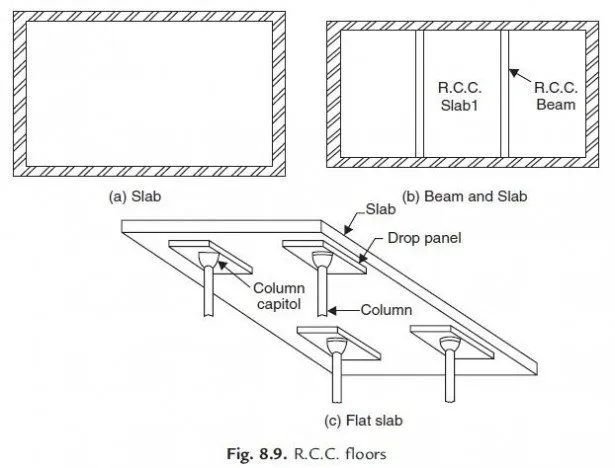
In R.C.C. concrete is used to resist compression and steel to resist tension. Hence the concrete in tension zone do not contribute in resisting the load. It just keeps the steel at required position. In reinforced brick slab an attempt is made to replace concrete in tension zone by bricks. It is better thermal efficient than solid concrete floors. Figure 8.10 shows a typical reinforced brick slab.
In ribbed or hollow tiled flooring, the concrete in tension portion is replaced by hollow tiles. Figure 8.11 shows a typical floor of this type.
In precast concrete floor panels may be used which helps in avoiding form works, storing of sand, coarse aggregates etc. at the site and also curing. Factories manufacture these units which are to be placed over supports in the structure. Figure 8.12 shows the cross-section of a typical precast floor unit. These units are available in 0.25 m widths and in various spans. Interlocking grooves are provided on the sides to get tight connection with adjoining units.


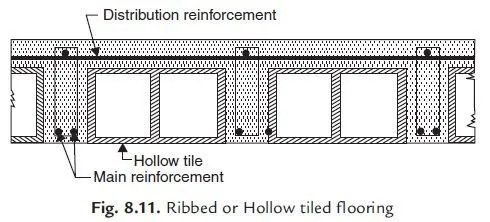

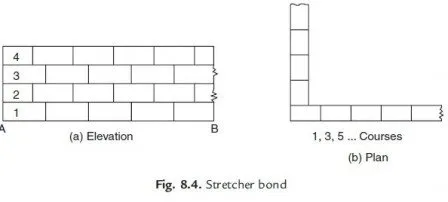

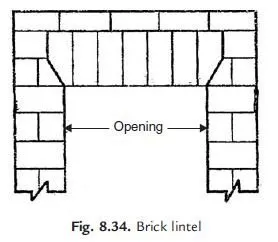
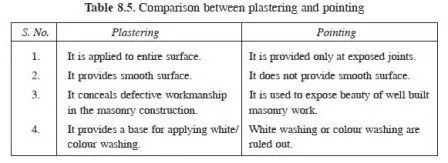
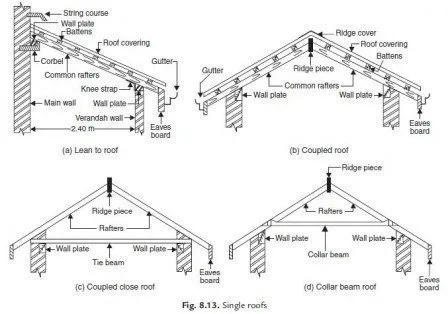
Steel distribution diagram for beam and slab, showing tension and compression zone. formula if you feel to be required required for better understanding.